YAMAHA YFM600FWA 2001 Manuale de Empleo (in Spanish)
Manufacturer: YAMAHA, Model Year: 2001, Model line: YFM600FWA, Model: YAMAHA YFM600FWA 2001Pages: 372, tamaño PDF: 10.01 MB
Page 141 of 372

5-30
FBU00160
Limite d’usure de pneu
Changer un pneu dont la profondeur de sculpture est ré-
duite à 3 mm.
SBU00160
Límite de desgaste de los neumáticos
Sustituya el neumático cuando la profundidad
del dibujo de éste se haya reducido a 3 mm debi-
do al desgaste.
Page 142 of 372

6-1
EBU00162
OPERATION
Read the Owner’s Manual carefully before
riding the ATV.
WARNING
Read the Owner’s Manual carefully to become
familiar with all controls. Loss of control could
cause an accident or injury. If there is a control
or function you do not understand, ask your
Yamaha dealer.
Page 143 of 372
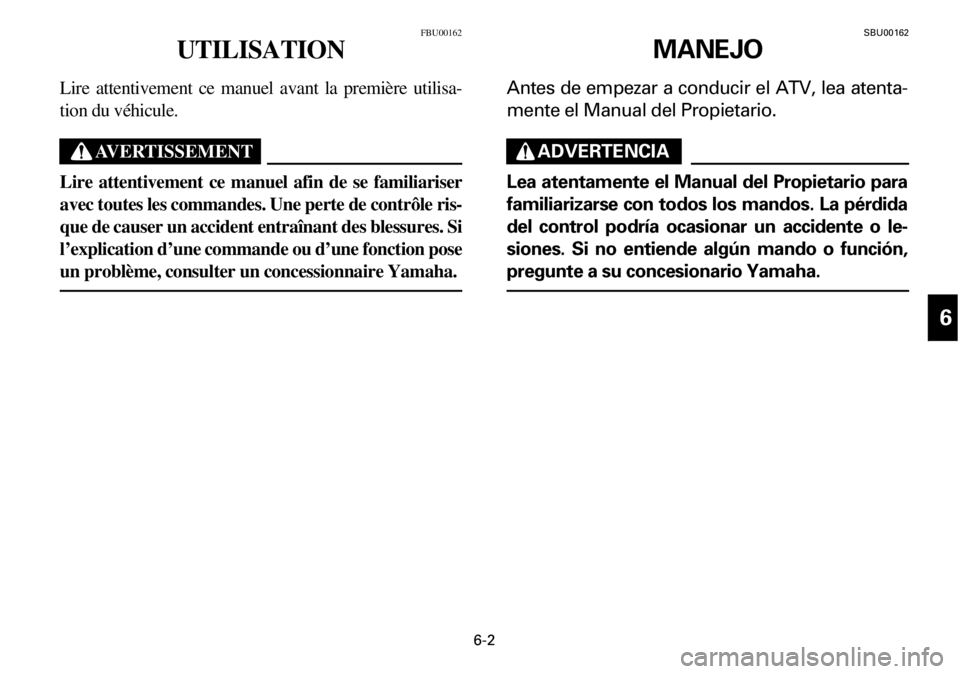
6-2
6
6
6
6
6
6
6
6
9
60
66
FBU00162
UTILISATION
Lire attentivement ce manuel avant la première utilisa-
tion du véhicule.
AVERTISSEMENT
Lire attentivement ce manuel afin de se familiariser
avec toutes les commandes. Une perte de contrôle ris-
que de causer un accident entraînant des blessures. Si
l’explication d’une commande ou d’une fonction pose
un problème, consulter un concessionnaire Yamaha.
SBU00162
MANEJO
Antes de empezar a conducir el ATV, lea atenta-
mente el Manual del Propietario.
ADVERTENCIA
Lea atentamente el Manual del Propietario para
familiarizarse con todos los mandos. La pérdida
del control podría ocasionar un accidente o le-
siones. Si no entiende algún mando o función,
pregunte a su concesionario Yamaha.
Page 144 of 372

6-3
EBU00506
Starting a cold engine
WARNING
Always make sure all control cables work
smoothly before you begin riding in cold
weather. If the control cables are frozen or do
not work smoothly, you could be unable to
control the ATV, which could lead to an acci-
dent or collision.
1. Set the parking brake.
2. Turn the fuel cock to “ON”.
3. Turn the main switch to “ON” and the en-
gine stop switch to “RUN”.
4. Shift the transmission into neutral.
Page 145 of 372
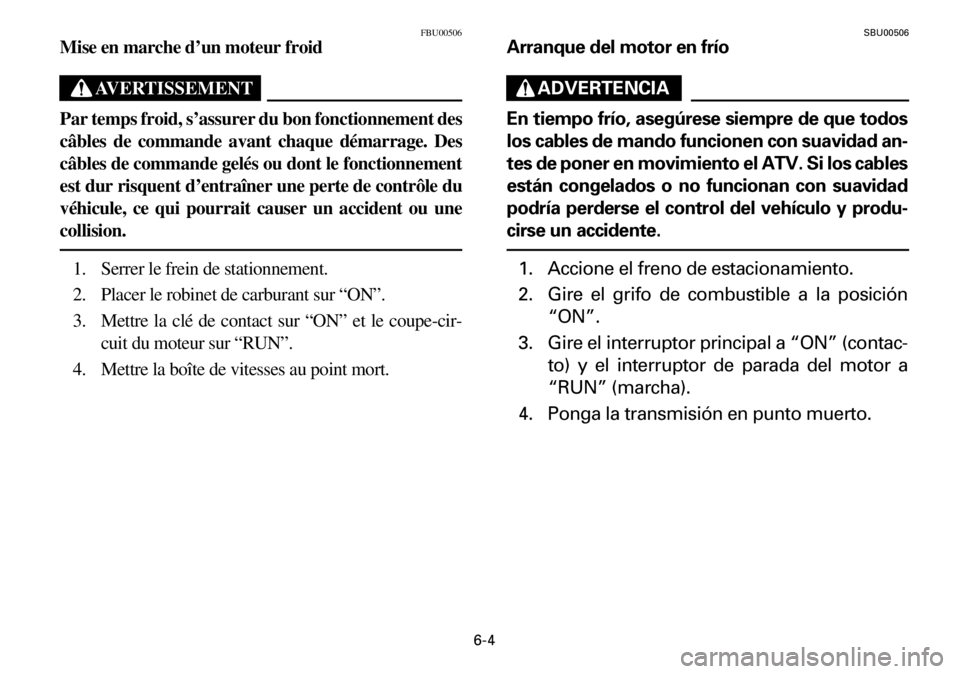
6-4
FBU00506
Mise en marche d’un moteur froid
AVERTISSEMENT
Par temps froid, s’assurer du bon fonctionnement des
câbles de commande avant chaque démarrage. Des
câbles de commande gelés ou dont le fonctionnement
est dur risquent d’entraîner une perte de contrôle du
véhicule, ce qui pourrait causer un accident ou une
collision.
1. Serrer le frein de stationnement.
2. Placer le robinet de carburant sur “ON”.
3. Mettre la clé de contact sur “ON” et le coupe-cir-
cuit du moteur sur “RUN”.
4. Mettre la boîte de vitesses au point mort.
SBU00506
Arranque del motor en frío
ADVERTENCIA
En tiempo frío, asegúrese siempre de que todos
los cables de mando funcionen con suavidad an-
tes de poner en movimiento el ATV. Si los cables
están congelados o no funcionan con suavidad
podría perderse el control del vehículo y produ-
cirse un accidente.
1. Accione el freno de estacionamiento.
2. Gire el grifo de combustible a la posición
“ON”.
3. Gire el interruptor principal a “ON” (contac-
to) y el interruptor de parada del motor a
“RUN” (marcha).
4. Ponga la transmisión en punto muerto.
Page 146 of 372
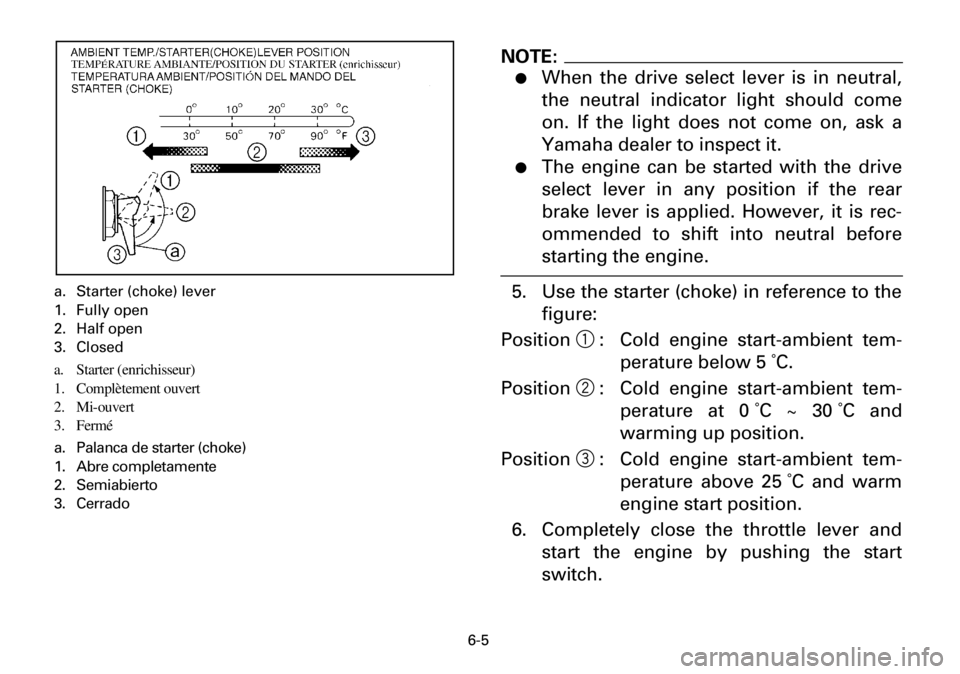
6-5
a. Starter (choke) lever
1. Fully open
2. Half open
3. Closed
a. Starter (enrichisseur)
1. Complètement ouvert
2. Mi-ouvert
3. Fermé
a. Palanca de starter (choke)
1. Abre completamente
2. Semiabierto
3. Cerrado
NOTE:
●When the drive select lever is in neutral,
the neutral indicator light should come
on. If the light does not come on, ask a
Yamaha dealer to inspect it.
●The engine can be started with the drive
select lever in any position if the rear
brake lever is applied. However, it is rec-
ommended to shift into neutral before
starting the engine.
5. Use the starter (choke) in reference to the
figure:
Position1 : Cold engine start-ambient tem-
perature below 5 ˚C.
Position2 : Cold engine start-ambient tem-
perature at 0 ˚C ~ 30 ˚C and
warming up position.
Position3 : Cold engine start-ambient tem-
perature above 25 ˚C and warm
engine start position.
6. Completely close the throttle lever and
start the engine by pushing the start
switch.
Page 147 of 372
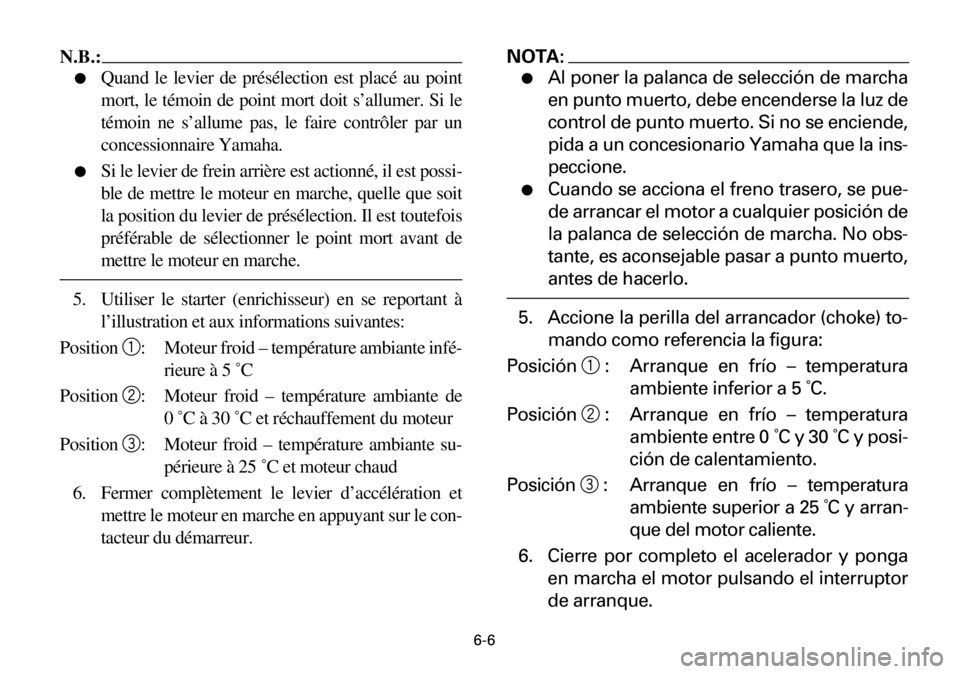
6-6
N.B.:
●Quand le levier de présélection est placé au point
mort, le témoin de point mort doit s’allumer. Si le
témoin ne s’allume pas, le faire contrôler par un
concessionnaire Yamaha.
●Si le levier de frein arrière est actionné, il est possi-
ble de mettre le moteur en marche, quelle que soit
la position du levier de présélection. Il est toutefois
préférable de sélectionner le point mort avant de
mettre le moteur en marche.
5. Utiliser le starter (enrichisseur) en se reportant à
l’illustration et aux informations suivantes:
Position1: Moteur froid – température ambiante infé-
rieure à 5 ˚C
Position2: Moteur froid – température ambiante de
0 ˚C à 30 ˚C et réchauffement du moteur
Position3: Moteur froid – température ambiante su-
périeure à 25 ˚C et moteur chaud
6. Fermer complètement le levier d’accélération et
mettre le moteur en marche en appuyant sur le con-
tacteur du démarreur.
NOTA:
●Al poner la palanca de selección de marcha
en punto muerto, debe encenderse la luz de
control de punto muerto. Si no se enciende,
pida a un concesionario Yamaha que la ins-
peccione.
●Cuando se acciona el freno trasero, se pue-
de arrancar el motor a cualquier posición de
la palanca de selección de marcha. No obs-
tante, es aconsejable pasar a punto muerto,
antes de hacerlo.
5. Accione la perilla del arrancador (choke) to-
mando como referencia la figura:
Posición1 : Arranque en frío – temperatura
ambiente inferior a 5 ˚C.
Posición2 : Arranque en frío – temperatura
ambiente entre 0 ˚C y 30 ˚C y posi-
ción de calentamiento.
Posición3 : Arranque en frío – temperatura
ambiente superior a 25 ˚C y arran-
que del motor caliente.
6. Cierre por completo el acelerador y ponga
en marcha el motor pulsando el interruptor
de arranque.
Page 148 of 372
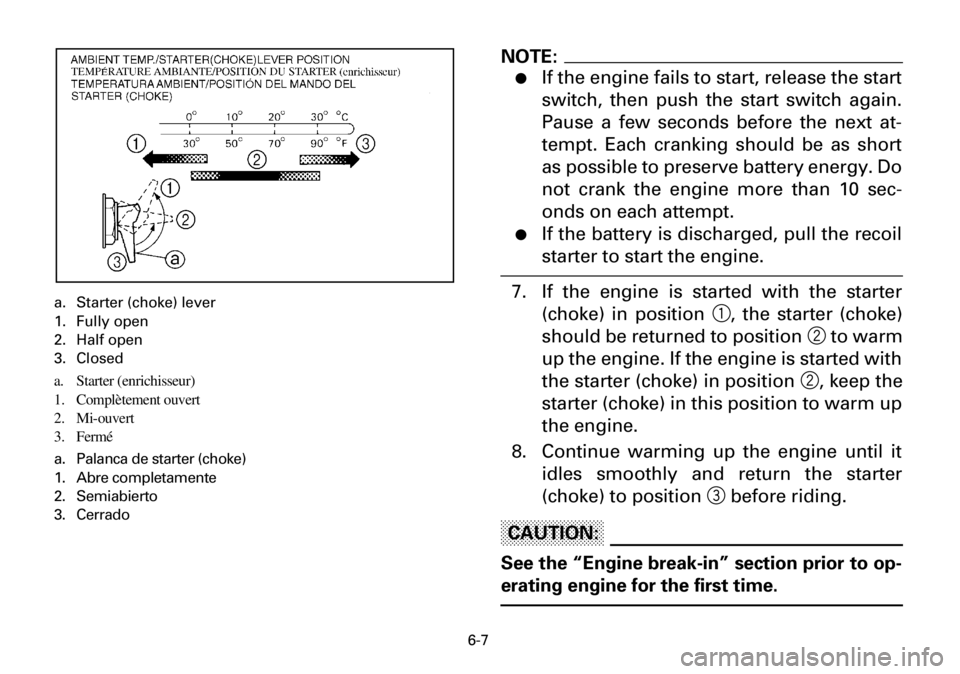
6-7
a. Starter (choke) lever
1. Fully open
2. Half open
3. Closed
a. Starter (enrichisseur)
1. Complètement ouvert
2. Mi-ouvert
3. Fermé
a. Palanca de starter (choke)
1. Abre completamente
2. Semiabierto
3. Cerrado
NOTE:
●If the engine fails to start, release the start
switch, then push the start switch again.
Pause a few seconds before the next at-
tempt. Each cranking should be as short
as possible to preserve battery energy. Do
not crank the engine more than 10 sec-
onds on each attempt.
●If the battery is discharged, pull the recoil
starter to start the engine.
7. If the engine is started with the starter
(choke) in position 1, the starter (choke)
should be returned to position 2 to warm
up the engine. If the engine is started with
the starter (choke) in position 2, keep the
starter (choke) in this position to warm up
the engine.
8. Continue warming up the engine until it
idles smoothly and return the starter
(choke) to position 3 before riding.
CAUTION:
See the “Engine break-in” section prior to op-
erating engine for the first time.
Page 149 of 372
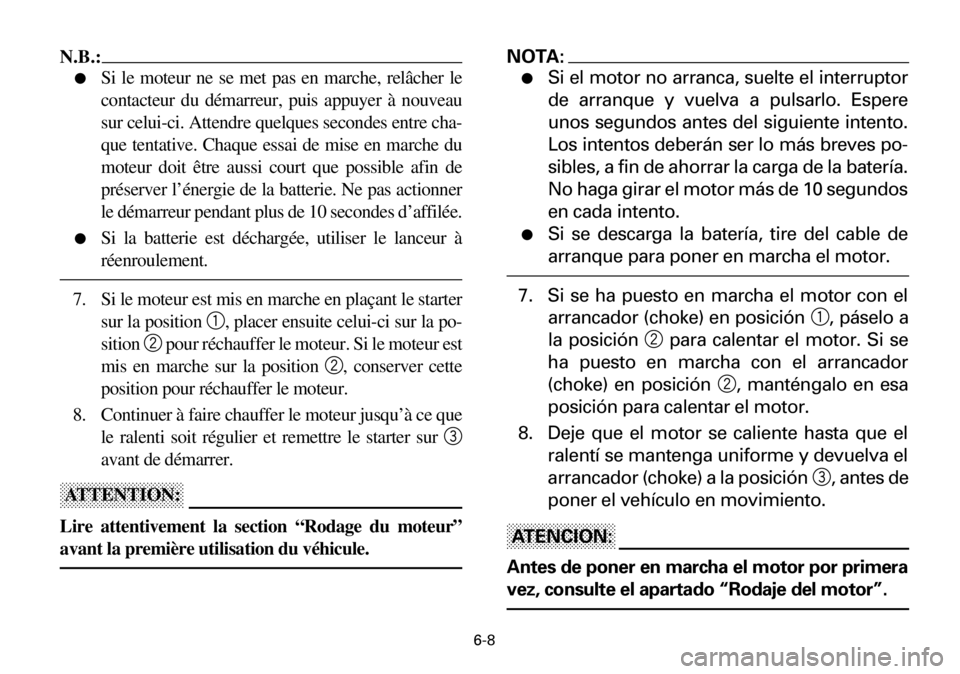
6-8
N.B.:
●Si le moteur ne se met pas en marche, relâcher le
contacteur du démarreur, puis appuyer à nouveau
sur celui-ci. Attendre quelques secondes entre cha-
que tentative. Chaque essai de mise en marche du
moteur doit être aussi court que possible afin de
préserver l’énergie de la batterie. Ne pas actionner
le démarreur pendant plus de 10 secondes d’affilée.
●Si la batterie est déchargée, utiliser le lanceur à
réenroulement.
7. Si le moteur est mis en marche en plaçant le starter
sur la position 1, placer ensuite celui-ci sur la po-
sition2 pour réchauffer le moteur. Si le moteur est
mis en marche sur la position 2, conserver cette
position pour réchauffer le moteur.
8. Continuer à faire chauffer le moteur jusqu’à ce que
le ralenti soit régulier et remettre le starter sur 3
avant de démarrer.
ATTENTION:ATTENTION:ATTENTION:ATTENTION:
Lire attentivement la section “Rodage du moteur”
avant la première utilisation du véhicule.
NOTA:
●Si el motor no arranca, suelte el interruptor
de arranque y vuelva a pulsarlo. Espere
unos segundos antes del siguiente intento.
Los intentos deberán ser lo más breves po-
sibles, a fin de ahorrar la carga de la batería.
No haga girar el motor más de 10 segundos
en cada intento.
●Si se descarga la batería, tire del cable de
arranque para poner en marcha el motor.
7. Si se ha puesto en marcha el motor con el
arrancador (choke) en posición 1, páselo a
la posición 2 para calentar el motor. Si se
ha puesto en marcha con el arrancador
(choke) en posición 2, manténgalo en esa
posición para calentar el motor.
8. Deje que el motor se caliente hasta que el
ralentí se mantenga uniforme y devuelva el
arrancador (choke) a la posición 3, antes de
poner el vehículo en movimiento.
ATENCION:
Antes de poner en marcha el motor por primera
vez, consulte el apartado “Rodaje del motor”.
Page 150 of 372

6-9
EBU00180
Starting a warm engine
To start a warm engine, refer to the “Starting a
cold engine” section. The starter (choke)
should not be used. The throttle should be
opened slightly.
EBU00182
Warming up
To get maximum engine life, always warm up
the engine before starting off. Never accelerate
hard with a cold engine! To see whether or not
the engine is warm, check if it responds to the
throttle normally with the starter (choke)
turned off.